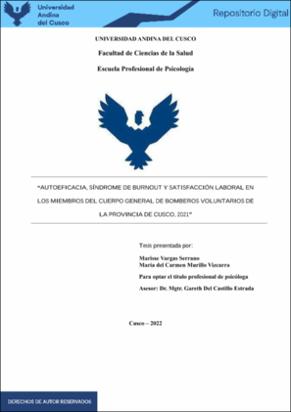| dc.contributor.advisor | Del Castillo Estrada, Gareth | |
| dc.contributor.author | Vargas Serrano, Marisse | |
| dc.contributor.author | Murillo Vizcarra, María del Carmen | |
| dc.date.accessioned | 2023-04-03T22:12:52Z | |
| dc.date.available | 2023-04-03T22:12:52Z | |
| dc.date.issued | 2022-12-27 | |
| dc.identifier.uri | https://hdl.handle.net/20.500.12557/5303 | |
| dc.description.abstract | El presente estudio de investigación tuvo como objetivo conocer la relación entre
autoeficacia, síndrome de burnout y satisfacción laboral en los miembros del cuerpo general
de bomberos voluntarios de la provincia de Cusco. Se utilizó un enfoque cuantitativo de
alcance descriptivo comparativo – correlacional con un diseño no experimental de corte
transversal, la población objeto de estudio estuvo conformada por 130 bomberos voluntarios
pertenecientes a las tres compañías de la provincia de Cusco. Para la obtención de los niveles
de autoeficacia se utilizó la Escala de Autoeficacia General de Baessler & Schwarzer, se
utilizó el inventario de Bournout de Maslach para identificar la presencia del síndrome de
burnout, y por último para la evaluación de la satisfacción laboral se utilizó la escala de
satisfacción laboral de Sonia Palma. Para el análisis de los datos se utilizó el estadístico para
las ciencias sociales (SPSS) y el chi - cuadrado para comprobar o anular las hipótesis
planteadas. Como resultado se obtuvo que existe una relación parcial entre las variables,
entendiendo que, si existe relación entre la autoeficacia y la satisfacción laboral, en cuanto a
los objetivos específicos se obtuvo que La mayoría de bomberos voluntarios cuenta con un
nivel de autoeficacia alta, no presenta síndrome de burnout y más de la mitad se ubica en el
nivel regular de satisfacción laboral. Como conclusión se llegó a que si el bombero voluntario
presenta un nivel alto de autoeficacia a la vez presentara satisfacción laboral, que la mayoría
de bomberos cuentan con un adecuado manejo frente al estrés por lo que no presentan
síndrome y que este a su vez no influye en su autoeficacia ni en su satisfacción laboral. La
presente investigación fue realizada en una población poco estudiada por lo que servirá como
antecedente para futura investigaciones especialmente enfocada en estas poblaciones. | es_PE |
| dc.description.abstract | The objective of this research study was to determine the relationship between self-efficacy,
burnout syndrome, and job satisfaction in members of the “Cuerpo general de bomberos
volntarios“ of the province of Cusco. A quantitative approach of descriptive comparative-
correlational scope was used with a non-experimental cross-sectional design, the study
population consisted of 130 volunteer firefighters belonging to the three companies of the
province of Cusco. To obtain the levels of self-efficacy, the Baessler & Schwarzer “Escala de
Autoeficacia general” was used, Maslach's Burnout inventory was used to identify the
presence of burnout syndrome, and finally, for the evaluation of job satisfaction, the “Escala
de satisfacción laboral de Sonia Palma” was used. For the analysis of the data Statistical
Package for the Social Sciences (SPSS) and the chi-square were used to verify or nullify the
hypotheses proposed. As a result, it was found that there is a partial relationship between the
variables, understanding that there is a relationship between self-efficacy and job satisfaction.
As for the specific objectives, it was found that most volunteer firefighters have a high level
of self-efficacy, do not have burnout syndrome and more than half of them have a regular
level of job satisfaction. As a conclusion, it was concluded that if the volunteer firefighter has
a high level of self-efficacy, he/she will also have job satisfaction, that most firefighters have
adequate stress management and therefore do not have burnout syndrome, and that this in
turn does not influence their self-efficacy or job satisfaction. This research was carried out in
a population that has not been studied much, so it will serve as a precedent for future research
especially focused on these populations. | en_US |
| dc.format | application/pdf | es_PE |
| dc.language.iso | spa | es_PE |
| dc.publisher | Universidad Andina del Cusco | es_PE |
| dc.rights | info:eu-repo/semantics/openAccess | es_PE |
| dc.rights.uri | https://creativecommons.org/licenses/by-nc-nd/4.0/ | es_PE |
| dc.subject | Autoeficacia | es_PE |
| dc.subject | Síndrome de burnout | es_PE |
| dc.subject | Satisfacción laboral | es_PE |
| dc.title | Autoeficacia, síndrome de burnout y satisfacción laboral en los miembros del Cuerpo General de Bomberos Voluntarios de la provincia de Cusco, 2021 | es_PE |
| dc.type | info:eu-repo/semantics/bachelorThesis | es_PE |
| thesis.degree.name | Psicóloga | es_PE |
| thesis.degree.grantor | Universidad Andina del Cusco. Facultad de Ciencias de la Salud | es_PE |
| thesis.degree.discipline | Psicología | es_PE |
| dc.publisher.country | PE | es_PE |
| dc.subject.ocde | https://purl.org/pe-repo/ocde/ford#5.01.00 | es_PE |
| renati.advisor.dni | 41884386 | |
| renati.advisor.orcid | https://orcid.org/0000-0001-8108-3802 | es_PE |
| renati.author.dni | 71939304 | |
| renati.author.dni | 73343773 | |
| renati.discipline | 313016 | es_PE |
| renati.juror | Gamio Gonzalez, Luis Fernando | |
| renati.juror | Calderón Córdova, Katherine | |
| renati.juror | Durand Guzman, Juan Segismundo | |
| renati.juror | Pezua Vásquez, Rocio Liney | |
| renati.level | https://purl.org/pe-repo/renati/level#tituloProfesional | es_PE |
| renati.type | https://purl.org/pe-repo/renati/type#tesis | es_PE |


